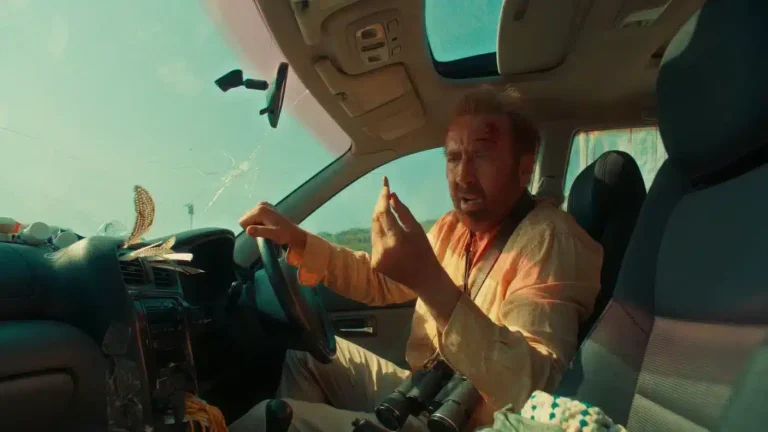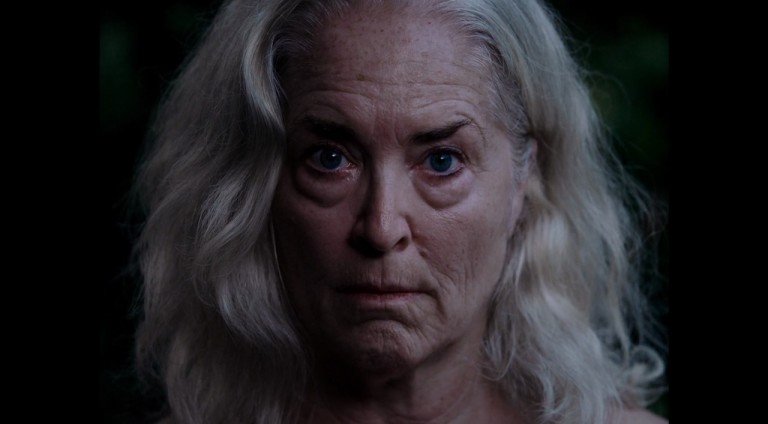“Mars Express” is one of those movies that takes in every aspect of the cyberpunk noir genre and creates a new story while focusing on developing a newer world. It would be a fool’s errand to wonder whether “Mars Express” becomes another touchstone for the cyberpunk genre. Considering the scarcity of movies being tackled in this genre – either live-action or animated – this movie feels like a breath of fresh air.
Mars Express (2024) Plot Summary and Movie Synopsis
Who was Aline and Carlos chasing?
The movie opens with two seemingly disconnected events occurring almost simultaneously. University student and hacker Jun Chow is seemingly murdered by an android in her dormitory room.
Back on Earth, which has become a “swamp for the unemployed,” Mars-based detective Aline Ruby and her android partner Carlos Riviera are after a notorious hacker named Roberta. Carlos, himself a casualty of a war called the Novigrad insurrection and now having his memories transferred inside an exoskeleton while a hologram of his head floats on top, poses as Roberta’s new customer. The purpose here is for Roberta to jailbreak robots—the robots would be granted free will without the induced limitations imprinted upon them by inception. The chase between Aline and Roberta concludes with a sleek action sequence.
Later, while explaining to Chris Royjacker, the businessman who had hired her to search for Roberta, she is ordered by Royjacker to wind down and enjoy herself. Carlos ultimately manages to capture Roberta, though that comes with Asimov-like programming subroutines that immediately disconnect him and render him immobile (or which stopped him directly punching his ex-wife’s husband in frustration, as his ex-wife has forbidden him to see their kid). Back on Mars, after having travelled via the “Mars Express” train, Roberta’s warrant is suspiciously deleted from the police files, leading to Aline and Carlos reluctantly letting Roberta go. While trying to explain to Chris Royjacker, the businessman who had hired her to search for Roberta, Royjacker orders her to wind down and enjoy.
What happens to Jun Chow?
However, that comes for nought, as Jun Chow’s disappearance soon captures Aline’s attention. On investigating her laboratory at the Alan Turing Campus, Aline realises via the hologram reconstruction that Jun had accidentally managed to jailbreak a robot while working on its internal schematics. The police had been looking for her as Jailbreaking had become illegal by the year 2200. Upon investigating Chow’s room, Aline finds homemade pills akin to Adderall. She and Carlos also locate Chow’s unfortunate roommate, who had been murdered in the opening sequence.
Meanwhile, the police also located the android that Jun had unfortunately hacked. Located beneath the bowels of the Mars civilization, both Aline and Homicide Inspector Simon Gardaux are stunned to find the robot, having gained sentience, redecorating the stone walls with runes and trying to seemingly build an aircraft to escape in the nothingness of space before being destroyed.
In trying to investigate that thread, mainly by questioning her professor as well as through trace dialogues by Jun’s parents, we learn that Jun Chow had been trying to pay her tuition bills by resorting to prostitution. As it turns out, synthetic prostitution or androids designed as prostitutes are all the rage on Mars. While investigating, both Aline and Carlos locate Chow, hard at work repairing one of the synthetic prostitutes. Carlos manages to catch the real Chow (and promptly gets disconnected), while Aline manages to catch the android, who is revealed to be Chow’s backup.
The officers question the two Chows and learn that a police officer had killed Chow’s roommate, Dominique. They are suddenly attacked by augmented humans, with one cutting android Chow’s head in two, while the rest chase Aline and Chow down. Before they could escape, Chow was shot down by the rest of the group that had been lying in wait. Chow’s death hits Aline pretty hard, forcing her to break her sobriety.
Who ordered Jun Chow to be murdered?
At Dominique’s funeral, Aline and Carlos realize that the augmented human had taken the disguise of Dominique’s father to gain access to her room before murdering her. They take the aid of Roberta (the hacker they had been chasing previously) and her robot aid, LEM. After watching the video of Chow’s android being jailbroken, Roberta reveals that this resembles more of a software takeover. A directive would be installed that orders these machines to act upon anything, even erasing all their prime directives, and would be transmissible between all androids.
Roberta also reveals that Royjacker had been responsible. When they had been chasing Roberta in the opening sequence, they thought Roberta had hacked into Royajacker’s server, but it had been the other way around. As Aline waits for Royjacker at his party, he gets a message via mind-link from Carlos, revealing that Royjacker had ordered Jun Chow’s murder.
Why was Jun Chow murdered?
To complete Roberta’s incomplete software takeover program, Royjacker outsourced it to brain farms. Jun had taken on the job through there, and all the memories of the software programming would be sent via stream to Royjacker. The psychoactive drug that Jun had been taking for exam purposes, however, had the adverse side effect of reconstituting the memories that had already been erased.
While the investigation is underway, Aline and Carlos are attacked mid-travel by the jailbroken androids, with Carlos managing to save Aline at the last second while Aline is being extracted out of the foam mesh in her collided vehicle. Their plan to infiltrate the NOCTIS police station to rejigger the android Chow ran the risk of Aline being under suspended detention and Carlos being decommissioned. Aline, knocking Incpsector Gardaux out, turns on Android Chow and requests to recall events when she had launched the code. As a consequence of the drug, human Chow, while working on her android, had recalled the code and accidentally wrote it in the final code. Royjacker had Chow murdered upon realising that she is a loose end, though he might not have been acting alone.
Mars Express (2024) Ending Explained – Did the robots survive?
How does the robot uprising begin?
Before Aline is arrested and imprisoned, her final conversation with robot Chow reveals that the newer robots, which had all been created by Royjacker, had the takeover code hidden beneath their last update, which will be launched at 6 p.m. Aline tries to convince the interrogator, but they don’t believe her; however, Gardaux later removes her restraints.
5 minutes before the clock strikes 6, Aline is visited by Royjacker’s AI robot and Aline’s friend Beryl. We are led to believe that Beryl shares a similar form of personal connection that Royjacker, Aline, and Carlos share as well, since they were comrades during the Novigrad incursion. Beryl tries to convince Aline to not believe all the propaganda against the robots before disappearing. As the clock strikes 6, the robot uprising begins, with a riot occurring inside the police station. In the middle of the robot exodus, the android Chow breaks open the door to Aline’s interrogation room.
Meanwhile, Carlos, who had been in the middle of disassembly, is also turned on. However, because his exoskeleton is an older model, the update containing the software takeover hadn’t been installed. Thus, he isn’t joining the robot exodus, instead choosing to follow Aline to Royjacker’s mansion, as the idyllic society of Mars, hidden beneath giant domes that cloak the darkness of space, slowly starts to fall apart.
While Aline and Carlos try to break into Royjacker’s mansion, Aline is thrown towards the top floor by Carlos, while Carlos begins fighting with the organic super-soldier AI at the courtyard, in a sequence very much calling back to the climactic fight in Mamoru Oshii’s “Ghost in the Shell.”
Does Aline die?
While Carlos is busy with the four-legged monster, Aline has Royjacker in a chokehold, gun pointed at the temple, while his soldiers look on dispassionately. Royjacker reveals that the takeover had been to remove the robots, and replace them with organic AI, developed inside invertebrates. As the screens show a newsfeed describing the androids’ exodus, the giant television screen fills up with multiple video-conference screens, revealing Royjacker’s benefactors, who had given him the fund to research organic AI. Carlos meanwhile destroys the monster by burning its tentacled insides with the exoskeleton’s radioactive core, but he is too late to rescue Aline, who is shot by the soldier a second before Carlos arrives and disarms him.
Do the robots survive?
In the final few minutes, “Mars Express” becomes ambiguous. The humans and the robots arrive at a violent impasse. For humans, it’s a chance to rebuild new AIs that aren’t at risk of gaining sentience by jailbreak or rogue software takeover due to their organic inmeshing. For the robots, it’s the chance to upload their core memories to a cloud server stored inside the spaceship that android Chow had been trying to build. Beryl had been working hard to build a transport such that the robots were capable of creating a civilization of their own via matter and energy that could be harnessed by all their core memories existing simultaneously inside a cloud server.
For Carlos, Aline being shot is the final excommunication from any tether of humanity. He tries to reconnect with his ex-wife but is met by shotgun blasts from her husband. He finally tries to vent out his frustration by chokeholding the husband but is stopped by the reflection of his daughter through the hologram reconstruction of his head. This, coupled with the fact that Aline is shot at the hip and bleeding profusely, makes him embrace his robot identity, and he joins in that exodus, finally giving up his soul to the ether-resembling cloud. The spaceship finally launches into deep space, leaving humanity behind to pick up the pieces of their destruction.
Mars Express (2024) Review
The best of cyberpunk always tries to show the balance between technology and humanity and the dilemma resulting from co-existence. The closest one attains in these universes as a result of co-existence would be varied forms of post-humanism: humanity augments itself with technology, partially by utilizing mind speak, or by installing connecting jacks to interconnect with hubs and devices seamlessly. The extreme stage would be to back up their memories in android bodies, forcing them to exist at the intersection of humans and machines. This brings to life the question of what ultimately constitutes humanity. If memory is the answer and duplication of said memory is possible, then would the android armed with the memories of the human being also constitute an original soul?
If one chooses to drown themselves in context, the similarities of Perein’s “Mars Express” with Mamoru Oshii’s “Ghost in the Shell”, Ridley Scott’s “Blade Runner”, or Philip K. Dick’s “Do Androids Dream of Electric Sheep” are pretty evident. The Oshii influence is striking even in some of the set pieces, from the opening action sequence to the finale between Carlos and the organic AI-infused monster. However, the difference lies in the storyteller’s choice of visual luxuriation. Perein is less invested in the philosophical discussion behind the ideas—the class divide between robots and humans—and more invested in the world’s technological advancements. The banality within the conversations—between Aline and her android partner Carlos, or hacker Roberta Williams and her sleek humanoid robot companion LEM – and the exploration of the human condition are tinged with nonchalance that contributes to the unique tonality.
Mars Express” operates very much within the neo-noir genre, but Perein never shies away from the visceral enjoyment of these animated stories. To underestimate the power of a “cool” image would be to take away the viewer’s engagement from a fun action sequence. It would also rob one of the surprise factors associated with a unique image. Perein, also focuses on the solution of the investigation, choosing a suitably overcooked plot but with enough propulsion in the pace. This creates a script that doesn’t delve deep enough into the plot mechanics or the specificities of how one event connects with the next. The smooth, sleek animation by Mikael Robert and the synth-heavy score by Philip Monthaye and Fred Avril help to tide over these fallacies.
The overall denouement of the investigation might feel a tad bit trivial, but the encapsulation of all the events coalescing produces a larger impact, especially within the final ten minutes of the film. It feels emotionally too heavy considering the banality the movie chooses to incorporate throughout its runtime. The banality however doesn’t take away from the movie choosing to tackle the paranoia of the current AI-led commercial space. Perein, thankfully, is humble enough to not provide a definitive answer, merely choosing to extrapolate what could happen.










